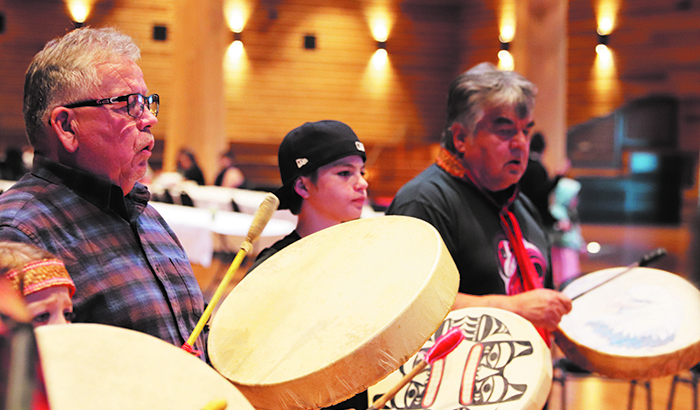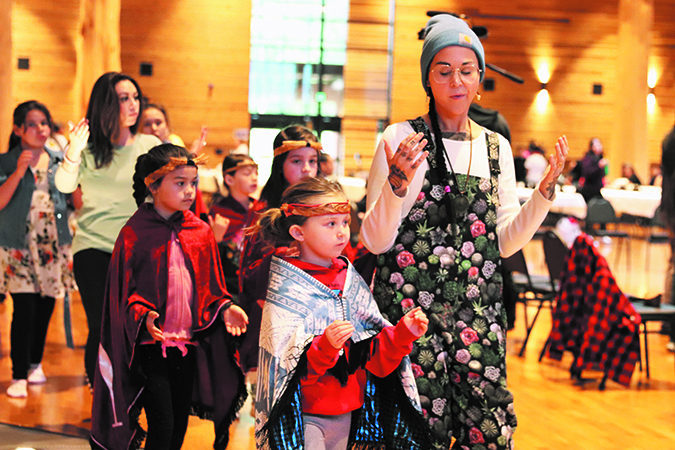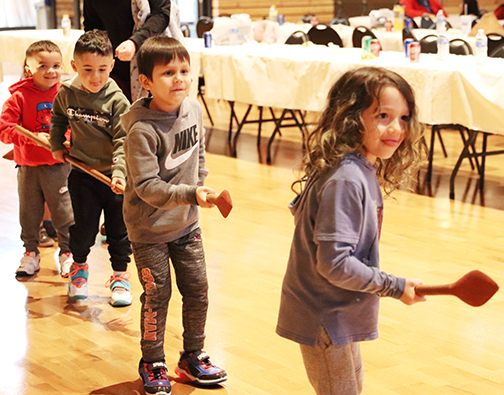
By Kalvin Valdillez, Tulalip News
“The elders taught us that we always need to be listening because some day you’ll be tapped on the shoulder to say something, to take over or lead something, and you need to be prepared,” said Tulalip tribal member, Glen Gobin. “Back in 1968, before the revival, they wanted the youth, which at the time included myself and my siblings, to start to learn some of the songs that we still use as part of the Salmon Ceremony today – the welcome song, the happy song. We were taught those songs at early age and I always felt honored to be a part of that.”
With less than a month to go, the tribal community of Tulalip continues to prepare for their annual Salmon Ceremony gathering, which will be held this year on Saturday June 11, beginning at 10:30 a.m. at the Tulalip Longhouse. Over the past four weeks, dancers, drummers and speakers have been getting reacquainted with their traditional songs by participating in weekly practice sessions, starting at 5:00 p.m., every Thursday.
The practices have been hosted at the Tulalip Gathering Hall, however, the final practice on June 9th will be held at the longhouse. During the approximate two-hour practice session, the tribe takes time to walkthrough the entire Salmon Ceremony from top to bottom, so the people can really get an understanding about what the songs and dances mean to the tribe, and why they are offered each year.

“I love being at the center of the longhouse when we’re all in there together and we all sing [The Prayer Song] for the first time,” Glen expressed. “The power of song with all our voices is very moving, you can feel it inside you. I try to get the kids to feel that – the power of our voices. It gives you strength and encouragement and it also makes you feel that you belong, that you fit in.”
Revived back in the mid-70’s, the Salmon Ceremony has become a staple tradition at the start of each fishing season for the people of Tulalip. During the ceremony, the tribe welcomes and honors the first king salmon to arrive at local waters. The ceremony also serves as a way to provide the fishermen of the tribe with a blessing before they hit the Salish Sea to harvest salmon for their people.
Prior to the assimilation era, the Salmon Ceremony was practiced by the Snohomish people since time immemorial. The ceremony was brought back in an historic effort by Harriette Shelton Dover and a handful of elders who were able to recall the songs and dances that were performed at the event. Those songs and dances were then passed on to the next generation. And ever since, the tribe has passed down the teachings year by year to the future of Tulalip.
Many Salmon Ceremony participants will be the first to tell that the practices leading up to the actual ceremony are equally important as the special day of honoring itself. Tribal leaders are welcoming the entire community out to the remaining practices, four in-total before the big day.
In 2020, for the first time since the revival, the Salmon Ceremony and all the practices were canceled due to the pandemic. In 2021, the tribe brought the ceremony back, but in an effort to limit the spread of COVID, there were no practices leading to the event. These important practices, where traditions are handed down to the next generations, were canceled for two straight years in a row, and the participants felt as if a significant piece to the ceremony was left out. Now with the return of the practices, the people feel a stronger connection to the songs, dances and stories that will be shared at the ceremony.
Said Glen, “It’s about giving respect to those that come from nature. But it also teaches about giving respect throughout life and honoring those gifts that we get and respecting our way of life in a good way. Part of that is making sure how we sing the songs, how we conduct ourselves, it teaches how to carry yourself in life. All of the songs have meaning, everything is connected. The songs encourage the people to carry themselves in a good way.”
In anticipation of the Salmon Ceremony, Tulalip News has been featuring a weekly mini-series focused on the all the important work that goes into the annual event. Over the past four weeks, we took a deeper look into the ceremony, highlighting its history and stories. This week, we sat down with Glen, the official Salmon Ceremony Leader, a title handed down from the late Stan ‘Scho-Hallem’ Jones and Bernie ‘Kai Kai’ Gobin, to go over the eleven songs, blessing and chants that are offered at the ceremony each and every year.

The Welcome Song
Glen: “The Welcome Song is well-known and it is Harriette Shelton Dover’s song. For a long time, when we sang her song, Harriette was the only one in front of everyone, with the strongest drummers and singers following behind her. Now we have four elders leading us, typically two times around the longhouse, to start the ceremony.”
Sduhubš War Song
“This is where all our young warriors line up with their spears. A while ago, I was back at D.C. at the National Archives building. In some of the writings there is a record of this song, the sduhubš war song. And it tells what the meaning is: I am Sduhubš, I am a fierce warrior. I have nothing but friends, for I have already killed all our enemies.”
Eagle/Owl Song (Tribute to Kai Kai)
“You know, Stan always called it the Eagle/Owl song, but nowhere in the song do we sing about the eagle. But anyway, it’s a Jones family song and he gave it to the ceremony. Scho-Hallem gathered Kai Kai, because they grew strength from each other and prayed for each other. Kai Kai was my father, him and Scho-Hallem were very close friends. They were very strong leaders for our tribe. They worked together as a team for our tribe to help us move forward to where we are today.”
Blessing Song
“The blessing of the fishermen! This was a song that was gifted to Stan and my dad by a lady named Bev Tom. It is about remembering your ancestors and remembering where you come from. It’s a blessing of the fishermen to wish them good luck and a safe season.”
Listen to our Prayers
“I love being at the center of the longhouse when we’re all in there together and we all sing this for the first time. The power of song with all our voices is very moving, you can feel it inside you.”
hikw siyab yubəč
“This song is one of the primary Salmon Ceremony songs. These are all prayer songs. We sing this all the way down to the beach, once yubəč is here. We sing this to greet our visitor. Once the canoe has landed, and he’s unloaded, he now leads the way. From this point for the rest of the ceremony, he’s at the front, nobody goes in front of him. We sing this all the way to the longhouse and then again when we take him back to the water. We recognize him, give thanks. He is the scout, he comes to see how well we are doing and if we treat him correctly, he’ll tell his people that the Tulalip’s are good people.”
Happy Song
“This is a crowd favorite where the Shawl Dance is performed. Back in 1968, before the revival, they wanted the youth, which at the time included myself and my siblings, to start to learn some of the songs that we still use as part of the Salmon Ceremony today – the welcome song, the happy song.
We were taught those songs at early age and I always felt honored to be a part of that. All of the songs have meaning, everything is connected. The songs encourage the people to carry themselves in a good way. And that goes back to the sduhubš people, we were always considered high class. But not high class like I’m better than you. Others viewed our people as siyab, high class people, because the way we carried our people.”
Table Blessing Song
“The table blessing song is thousands of years old, it’s been around that long and that’s how it was shared with us. It’s a very powerful song. It’s not often that you have a prayer song that has that fast of a beat, that you sing it that loud. Maybe it’s a joyous prayer. We all take a small piece of fish and eat the guest at the same time. Then we all take a drink of a half-glass of water together at the same time.”
Canoe Song (Kenny Moses Jr.’s Song) & New Beginnings Cleansing Song (Glen’s Song)
“Through the years we added some songs at the end. It used to end to stop at hikw siyab yubəč, but then the canoes still had to paddle out. That’s when Kenny’s song came. We started singing Kenny’s song for the canoe returning to the shore once more.
But then the girls wanted another song that they could dance to, because they didn’t want to leave, so I shared my song at the end. It’s a song of cleansing and new beginnings. It’s about, as you walk through life, you gather up all these things and you hang on to them. At different times you need to start to release them, because either some of those things start to bother you or you no longer need them so you release those things and only keeps what gives you strength and keeps you going. So you’re starting over again, that new beginning and you’re cleansing by releasing what doesn’t serve you.
When that song came to me, it was weird because I never thought I would receive a song. We were doing some spiritual work, canoes were put away for a year, we brought them back out and brushed them off and put them in the water. We were coming back by the longhouse and I was coming up the hill and the song started coming to me like a ton of bricks. I got home and sang it for about two hours. I drove around all week, singing it all the time. It wouldn’t leave. So finally I called Kenny Moses Jr. He came up to my dad’s house and I sang it there. He asked me about what I was thinking of and feeling at the time. It’s kind of a cleansing song about new beginnings.”